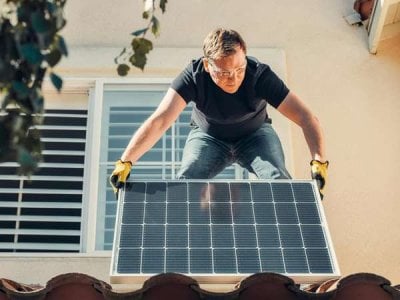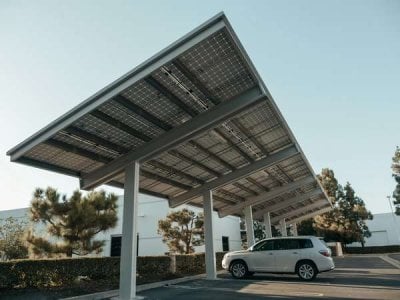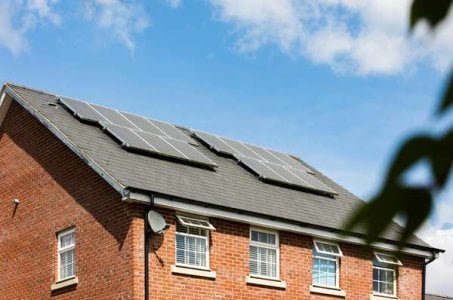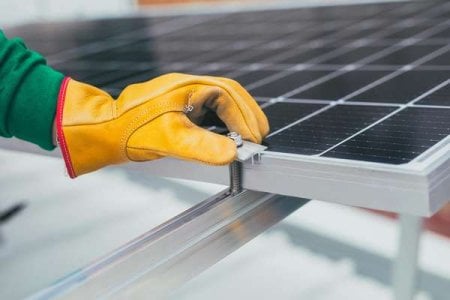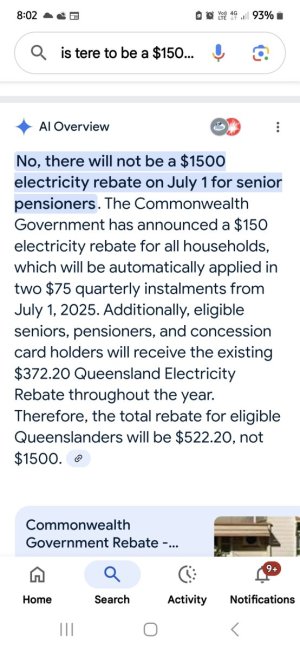Incoming NSW $1,500 rebate: Will it be a critical lifeline as power bills bite?
By
Danielle G.
- Replies 34
Editor’s note (12 June 2025): An earlier version of this article implied the new $1,500 rebate was available nationwide.The rebate actually applies only to New South Wales households and small businesses that install an eligible home-battery system and connect it to a Virtual Power Plant (VPP) under the NSW Peak Demand Reduction Scheme. We regret the error and have added a section below for readers in other states.
For many older Australians, opening the power bill has become a source of anxiety. Electricity prices have surged in recent times – by an average of 26% in 2023 alone. This spike in energy costs, combined with broader cost-of-living pressures, means that more seniors are finding it hard to make ends meet.
In response, households and small businesses in New South Wales will have access to an expanded financial incentive for investing in solar battery systems starting July 1. Under a joint initiative from the NSW and federal governments, the available rebate has been nearly doubled—from $800 to a generous $1,500.
This upgraded support is designed to reward those who install a battery and connect it to a Virtual Power Plant (VPP)—a smart network of solar batteries that allows surplus energy to be shared with the grid. The goal: to bolster grid resilience and drive down electricity costs for all.
The question is: will this new rebate offer real relief for those over 60 struggling with rising bills, or is it just a temporary band-aid? In this editorial, we’ll break down what the rebate means, who can get it, how it might help, and hear from seniors themselves. Let’s dive into why this support is arriving now and how it could make a difference in the everyday lives of older Australians.
It’s no secret that the cost of living in Australia has been climbing, and power bills are a big part of the squeeze. Over the past year, energy prices have skyrocketed, leaving many retirees and pensioners wondering how to cope. In one recent survey, 80% of Australians over 50 said they’ve been affected by rising living costs, with energy bills high on the list of concerns. For those on fixed incomes like the Age Pension or modest superannuation, a jump in the electricity rate can throw the household budget into turmoil. Heating, cooling, cooking – these basic needs are getting more expensive, and seniors often feel the pinch the most.
This is the backdrop against which the government rolled out the new $1,500 energy rebate. Essentially, it’s a relief payment applied to your power bills, aimed at taking the sting out of those price hikes. The timing isn’t a coincidence. Not only have power bills risen sharply, but broader inflation has been stubborn. By injecting this relief, the government hopes to cushion vulnerable households and, interestingly, help tame inflation as well. In fact, when a smaller round of rebates was given last year, it helped lower electricity bills by about 9.5% and even brought local inflation down a notch. In other words, taking some costs off consumers’ plates can slow overall price growth. So the rebate isn’t just about generosity – it’s also an attempt to ease a broader economic problem by directly reducing what people pay for power.
So, what exactly is this $1,500 energy rebate and who can claim it? First off, it helps to know that the rebate is primarily targeted at those who are feeling the pressure most – which includes a lot of seniors. The government has outlined a range of eligible groups. You’re in luck if you belong to any of these categories:
In short, most older Australians who are either on a government payment or have a concession card will be eligible. If you’re a self-funded retiree over 60, the key is whether you hold a Commonwealth Seniors Health Card – that’s the ticket to this rebate for those not on Centrelink payments.
What if I live outside NSW?
Even if you can’t claim the $1,500 NSW battery incentive, there’s still help on offer:
*Figures current as of 12 June 2025; check your state or territory government’s concessions page for updates.
Tip: Most credits appear automatically on your bill. If you haven’t seen them by the end of the quarter shown above, ring your retailer or the relevant concession hotline and have your account number handy.
One important thing for seniors: this rebate will not affect any of your other entitlements. It’s not counted as taxable income, and it doesn’t reduce your pension or other benefits. In other words, you won’t be penalized elsewhere for accepting this help. It’s truly meant to be a no-strings, no-catch relief measure. If you’re an age pensioner or a veteran on a DVA payment, you’ll keep all your regular payments and get the power rebate on top – a bit of a rare win-win in the social security space.
There’s a reason this rebate is being warmly welcomed by many seniors (and the organizations that represent them). If you’re on a fixed income, like the Age Pension or a set amount of retirement savings per year, unexpected cost spikes are your worst enemy. Unlike the workforce, you can’t easily pick up extra hours or a side gig to cover a bigger bill. Every dollar has to come from the same limited pot. That’s why a $1,500 cut in power bills can feel like a lifesaver.
Think about it: Australian households on average spend a couple of thousand dollars a year on electricity. In Queensland, for example, the typical annual power bill is around $2,000 – and a $1,000 rebate there will nearly halve the average yearly bill for 2024-25. Now, the new national rebate is up to $1,500, which is even more substantial. If your yearly bill is similar to the average, this could knock out almost half of what you’d normally pay for electricity. That’s a lot of breathing room.
For seniors, that freed-up money doesn’t go into extravagances. It goes into essentials. We’re talking about groceries, medical expenses, home repairs, or maybe finally replacing that aging fridge with a more energy-efficient model. One pensioner couple in Melbourne mentioned that a previous, smaller rebate let them catch up on some medical bills and fix their old heater before winter – things they had been putting off. When every cent counts, a boost like this can improve day-to-day comfort and security. Council on the Ageing has noted that older Australians often cut back on heating or cooling to save money, which can be dangerous to their health. With this rebate, fewer seniors might have to make those risky trade-offs between staying warm (or cool) and sticking to a tight budget.
It’s also worth noting the psychological relief this brings. Many older Australians carry a lot of stress about finances – more than half worry they might outlive their savings. Constantly rising bills feed that anxiety. A big rebate signals that help is on the way, which can ease stress levels. Knowing that for the next year you’ll have a lighter load on the electricity front makes it easier to plan the rest of your finances. Seniors on the pension usually budget down to the dollar. If you suddenly hand them back $300 a quarter (in the form of a smaller bill), that money can be reallocated to improve quality of life – maybe a bit more fresh food in the shopping basket or the ability to take a taxi to a doctor’s appointment instead of juggling multiple buses.
Still, we should keep expectations realistic. Fixed income households will benefit from the rebate, but energy prices aren’t necessarily done rising for good. The rebate buys time and breathing space. It’s a welcome short-term relief for those hardest hit, but it doesn’t solve longer-term issues like improving energy efficiency in the home or the fact that pensions often lag behind true cost-of-living increases. Seniors groups are grateful for the help yet continue to advocate for more sustainable solutions – like raising the rate of rent assistance or ongoing concessions – to ensure older people aren’t left in the cold (literally and figuratively) when the next bill arrives after the rebate period is over.
To understand how meaningful this rebate could be, let’s look at a couple of real-world scenarios that Australian seniors are facing.
Take Doreen Fawcett, a retiree featured in an ABC News story, who lives with her husband in a draughty post-war home. With her husband’s health in decline – he has serious lung and heart conditions – keeping the heater on in winter isn’t a luxury, it’s a necessity. But Doreen’s electricity plan charges peak rates for 14 hours a day, meaning power costs more than double during most of the hours she actually needs it. By 3pm each day, the rates spike, and they stay high well into the night. This leaves Doreen facing an awful daily dilemma: run the heating to keep her ill spouse warm and rack up big charges, or switch it off to avoid crippling bills. She jokes darkly that the cheapest time to run appliances is when they’re asleep – between 1am and 6am – an impractical solution for an elderly couple. This is what bill shock looks like for many seniors: tough choices that can literally affect their health.
Now imagine what a $1,500 credit could do for someone like Doreen. In her case, it might cover several months’ worth of the peak rates that have been punishing her wallet. Instead of constantly worrying about the next bill, she could keep the heat on during those chilly evenings without the same level of guilt or fear. Realistically, a rebate won’t make her energy tariff less complex, but it will soften the financial blow. It’s a bit of breathing space – a chance to use electricity in the way it’s needed, when it’s needed, with less anxiety.
Another example comes from Queensland’s recent experience with energy rebates. The Sunshine State took the lead with a very generous program: every single Queensland household received a $1,000 credit on their power bill from July 2024. For eligible seniors and pensioners in Queensland, the total relief was even higher – $1,372 off their power bills when combining that universal credit with additional state concessions. The impact was immediate and dramatic. Most Queenslanders found that they didn’t have to pay a cent on their next electricity bill after the rebate hit, and many won’t pay another bill until well into 2025. Picture that: an entire quarter or more with no power bills at all. For an elderly person on a fixed income, not getting an electricity bill for a few months can be game-changing. It means the money that would’ve gone to the energy company can now go towards other pressing needs. One Gold Coast pensioner reportedly said she used the respite to stock up on some groceries and pay her car rego – expenses she was worried about covering before.
These stories highlight a key point: the rebate is not abstract. It’s making a concrete difference for real people. Whether it’s allowing a couple to keep medical equipment running or simply removing the dread of the quarterly bill arriving, this relief can improve daily life. However, it’s also clear that it’s a short-term fix. The Queensland example is perhaps the most extreme (it’s been called the biggest such rebate by any Australian state ever), and even there, it’s a one-off injection. Folks like Doreen will be helped in the short run, but what happens when the next cycle of bills comes and the credits have been used up? These case studies show both the immense value of immediate relief and the lingering vulnerabilities that seniors face in the energy market.
Beyond individual households, you might be wondering what a large-scale $1,500 rebate means for the economy and taxpayers at large. After all, such relief isn’t free money – it’s effectively government funds (from taxes or other revenue) being channeled back to consumers. There are a few layers to the economic impact worth unpacking.
On one hand, putting money back in consumers’ pockets can be a boost for the economy. Seniors who have extra cash because their power bill went down might spend that money in local shops, on services, or to pay for healthcare. That’s money circulating through businesses rather than going to utilities. In economic terms, the rebate can stimulate a bit of extra consumer spending, which is helpful at a time when high living costs have people tightening their belts. It’s targeted too – it goes to those likely to spend it rather than save it. Many retirees will use the relief to purchase necessities they might have been postponing. This can have a small but positive effect on local economies (think of it as a mini “stimulus package” directed at older Aussies and low-income families).
Moreover, the rebate acts as a shield against inflation in a peculiar way. Normally, giving households money could be inflationary (more spending power chasing goods). But here, because the money is specifically offsetting high energy prices, it’s actually countering inflation in the energy sector. The ACCC found that in late 2023, without government rebates, electricity bills would have been about 14% higher for consumers – that’s how much those rebates prevented in cost increases. In Queensland, as mentioned earlier, rebates led to noticeably lower inflation locally because energy costs didn’t climb as much. Essentially, the rebate is absorbing what would have been a price shock. Instead of consumers paying out and feeling poorer (and then demanding higher wages or cutting spending, which has its own economic ripple effects), the government shoulders some of that burden. It’s a form of inflation control, albeit one that comes with a price tag to the budget.
Speaking of price tag: a nationwide $1,500 rebate to millions of households is a significant expenditure. The federal government, together with states, has committed billions towards energy bill relief programs. For instance, the recent package was on the order of $3.5 billion to fund these rebates across the country. It’s fair to ask, how can we afford this, and is it worth it? The government’s argument is that relieving cost-of-living stress now will pay off by preventing a deeper economic slowdown (because if people can’t pay their bills, they’ll cut spending elsewhere dramatically). There’s also a social dividend: reducing energy poverty means fewer people might need emergency assistance or healthcare interventions (imagine the costs if thousands of seniors got sick from not heating their homes). In theory, that could save public money down the track. Additionally, one could view this as a transfer from the public purse to households that immediately need it – a redistribution aimed at fairness during an energy crisis.
However, not everyone is applauding. Some critics point out that $1,500 for each household is a short-term fix and doesn’t address the root causes of high energy prices. Those causes include things like grid infrastructure costs, the global price of fuel, and the transition to renewables. If those fundamentals don’t change, prices could keep rising after the rebate money is spent. There’s also the question of whether such broad assistance is necessary for everyone eligible. For example, some relatively comfortable self-funded retirees with a Seniors Health Card will still get the rebate, even if they’re not struggling. (The flip side is that means-testing everything strictly can delay rollout and complicate things, so there’s a trade-off between precision and speed here.)
Another angle is how this might affect the energy market. There’s a concern that if consumers are insulated from high prices, they have less incentive to reduce usage or shop around for better deals. But given this is a one-year measure, it’s unlikely to make people complacent – nobody actually enjoys paying high bills, rebate or not. If anything, the publicity around the rebate might prompt more seniors to review their energy plan or access other concessions (many don’t realize they can ask their retailer for a better rate). The government has also paired bill relief with longer-term strategies, like investments in renewables and grid updates, aiming to bring wholesale prices down in the future. Those won’t pay off overnight, though. For now, the rebate is a stop-gap to get people through the current storm.
In summary, the economic impact of the $1,500 energy rebate has a silver lining: it cushions consumers and can stimulate spending, and it helped blunt a potential inflation spike in power prices. The broader cost is substantial and ultimately borne by taxpayers, but the consensus seems to be that preventing widespread hardship – especially among seniors and low-income families – is worth the expense. As with any relief measure, it’s a balancing act between immediate needs and long-term solutions. And that leads to the final point of reflection.
The $1,500 energy rebate is arriving as a welcome relief for countless older Australians. It’s informal in concept but powerful in effect: a bit of the pressure is coming off. We’ve seen how it can help someone like Doreen keep her heating on, and how an entire state of seniors breathed easier when their bills temporarily vanished. The rebate underscores a simple truth: when people aren’t crushed by one exorbitant expense, they can focus on living, not just scraping by.
Yet, it’s also clear that this is temporary relief. It’s a one-time (or one-year) measure, not a permanent reduction in tariffs. After it’s used up, the underlying issues remain. Energy costs may continue to rise in coming years, and many seniors will still be on fixed incomes, still budgeting carefully, still vulnerable to the next surge in prices. The rebate could be renewed or expanded in the future, but that depends on political will and economic conditions. There’s also the matter of complementary measures: improving energy efficiency in homes (so bills don’t run so high in the first place), raising pensions in line with real living costs, and providing better advice and support to seniors about managing utilities.
For now, older Australians can look forward to a bit of a buffer. It’s certainly a positive development in an otherwise challenging time for those balancing their household books. The tone of this rebate is conversational and understanding – much like we’ve taken in this article – acknowledging that behind every power bill is a person or a couple doing their best to get by.
So, as we wrap up, it’s worth pondering the bigger question: Will this $1,500 rebate simply tide seniors over for now, or can it spark a broader change in how we support our aging population amid rising costs? Only time will tell, but at least for the next year, the crackle of the heater or the hum of the aircon might sound a little more comforting knowing that help is in hand. And that leads us to ask – when the credits run out and the next challenge comes, how will we continue to ensure our seniors aren’t left out in the cold?
For many older Australians, opening the power bill has become a source of anxiety. Electricity prices have surged in recent times – by an average of 26% in 2023 alone. This spike in energy costs, combined with broader cost-of-living pressures, means that more seniors are finding it hard to make ends meet.
In response, households and small businesses in New South Wales will have access to an expanded financial incentive for investing in solar battery systems starting July 1. Under a joint initiative from the NSW and federal governments, the available rebate has been nearly doubled—from $800 to a generous $1,500.
This upgraded support is designed to reward those who install a battery and connect it to a Virtual Power Plant (VPP)—a smart network of solar batteries that allows surplus energy to be shared with the grid. The goal: to bolster grid resilience and drive down electricity costs for all.
The question is: will this new rebate offer real relief for those over 60 struggling with rising bills, or is it just a temporary band-aid? In this editorial, we’ll break down what the rebate means, who can get it, how it might help, and hear from seniors themselves. Let’s dive into why this support is arriving now and how it could make a difference in the everyday lives of older Australians.
Why an Energy Rebate – and Why Now?
It’s no secret that the cost of living in Australia has been climbing, and power bills are a big part of the squeeze. Over the past year, energy prices have skyrocketed, leaving many retirees and pensioners wondering how to cope. In one recent survey, 80% of Australians over 50 said they’ve been affected by rising living costs, with energy bills high on the list of concerns. For those on fixed incomes like the Age Pension or modest superannuation, a jump in the electricity rate can throw the household budget into turmoil. Heating, cooling, cooking – these basic needs are getting more expensive, and seniors often feel the pinch the most.
The situation has reached a point where seniors’ advocacy groups and economists alike have been sounding the alarm. The Council on the Ageing (COTA) reports that six in ten older Australians are experiencing financial stress that harms their quality of life, especially those dependent on the pension. Many are already cutting back on non-essentials, and some face heartbreaking choices – like whether to run the heater in winter or save that money for groceries. High energy costs hit older people hard because they typically spend more time at home (using electricity during the day) and often live on fixed budgets that don’t keep up with inflation. It’s a perfect storm of pressure: prices climbing while incomes stay put.
This is the backdrop against which the government rolled out the new $1,500 energy rebate. Essentially, it’s a relief payment applied to your power bills, aimed at taking the sting out of those price hikes. The timing isn’t a coincidence. Not only have power bills risen sharply, but broader inflation has been stubborn. By injecting this relief, the government hopes to cushion vulnerable households and, interestingly, help tame inflation as well. In fact, when a smaller round of rebates was given last year, it helped lower electricity bills by about 9.5% and even brought local inflation down a notch. In other words, taking some costs off consumers’ plates can slow overall price growth. So the rebate isn’t just about generosity – it’s also an attempt to ease a broader economic problem by directly reducing what people pay for power.
Who Is Eligible and How Do You Get It?
So, what exactly is this $1,500 energy rebate and who can claim it? First off, it helps to know that the rebate is primarily targeted at those who are feeling the pressure most – which includes a lot of seniors. The government has outlined a range of eligible groups. You’re in luck if you belong to any of these categories:
- Age Pension recipients (if you receive the Age Pension, you’re eligible)
- Disability Support Pension or Carer Payment recipients (many seniors who are carers fall here)
- Commonwealth Seniors Health Card holders (self-funded retirees with this card are included)
- Veterans and war widows/widowers on pensions
- Other concession card holders (for example, those on JobSeeker, Youth Allowance, or Family Tax Benefits also qualify, recognizing that cost-of-living relief needs to be broad)
- Low-income households registered for state energy concessions (each state/territory has schemes – if you’re already in one, you likely qualify automatically)
In short, most older Australians who are either on a government payment or have a concession card will be eligible. If you’re a self-funded retiree over 60, the key is whether you hold a Commonwealth Seniors Health Card – that’s the ticket to this rebate for those not on Centrelink payments.
What if I live outside NSW?
Even if you can’t claim the $1,500 NSW battery incentive, there’s still help on offer:
| Where you live | What’s on the table right now* |
| All states & territories | $300 National Energy Bill Relief Fund credit automatically applied to household electricity bills across four quarterly instalments in 2024-25.(energy.gov.au) |
| Queensland | $1,000 Cost-of-Living Electricity Rebate from 1 July 2024. Applied automatically.(qld.gov.au) |
| Victoria | New $100 Power Saving Bonus for eligible concession-card holders (opening soon) + the $300 federal credit.(energy.vic.gov.au) |
| South Australia | Annual Cost-of-Living Concession payment – $261.90 in 2025-26 (you must apply once only).(sa.gov.au) |
| Western Australia | 2024 households received a $700 credit; for 2025-26 the federal $150 top-up is confirmed while WA’s own rebate for 2025-26 is yet to be announced.(ecawa.org.au) |
| Tasmania | $250 state dividend (two × $125) plus the $300 federal credit.(auroraenergy.com.au) |
| Northern Territory | Up to $300 bill relief for 2024-25 (automatic for most grid customers, claimable for off-grid/embedded networks).(nt.gov.au) |
| Australian Capital Territory | Up to $300 bill relief credit for 2024-25 (automatic for most customers).(revenue.act.gov.au) |
*Figures current as of 12 June 2025; check your state or territory government’s concessions page for updates.
Tip: Most credits appear automatically on your bill. If you haven’t seen them by the end of the quarter shown above, ring your retailer or the relevant concession hotline and have your account number handy.
One important thing for seniors: this rebate will not affect any of your other entitlements. It’s not counted as taxable income, and it doesn’t reduce your pension or other benefits. In other words, you won’t be penalized elsewhere for accepting this help. It’s truly meant to be a no-strings, no-catch relief measure. If you’re an age pensioner or a veteran on a DVA payment, you’ll keep all your regular payments and get the power rebate on top – a bit of a rare win-win in the social security space.
Relief for Seniors on Fixed Incomes
There’s a reason this rebate is being warmly welcomed by many seniors (and the organizations that represent them). If you’re on a fixed income, like the Age Pension or a set amount of retirement savings per year, unexpected cost spikes are your worst enemy. Unlike the workforce, you can’t easily pick up extra hours or a side gig to cover a bigger bill. Every dollar has to come from the same limited pot. That’s why a $1,500 cut in power bills can feel like a lifesaver.
Think about it: Australian households on average spend a couple of thousand dollars a year on electricity. In Queensland, for example, the typical annual power bill is around $2,000 – and a $1,000 rebate there will nearly halve the average yearly bill for 2024-25. Now, the new national rebate is up to $1,500, which is even more substantial. If your yearly bill is similar to the average, this could knock out almost half of what you’d normally pay for electricity. That’s a lot of breathing room.
For seniors, that freed-up money doesn’t go into extravagances. It goes into essentials. We’re talking about groceries, medical expenses, home repairs, or maybe finally replacing that aging fridge with a more energy-efficient model. One pensioner couple in Melbourne mentioned that a previous, smaller rebate let them catch up on some medical bills and fix their old heater before winter – things they had been putting off. When every cent counts, a boost like this can improve day-to-day comfort and security. Council on the Ageing has noted that older Australians often cut back on heating or cooling to save money, which can be dangerous to their health. With this rebate, fewer seniors might have to make those risky trade-offs between staying warm (or cool) and sticking to a tight budget.
It’s also worth noting the psychological relief this brings. Many older Australians carry a lot of stress about finances – more than half worry they might outlive their savings. Constantly rising bills feed that anxiety. A big rebate signals that help is on the way, which can ease stress levels. Knowing that for the next year you’ll have a lighter load on the electricity front makes it easier to plan the rest of your finances. Seniors on the pension usually budget down to the dollar. If you suddenly hand them back $300 a quarter (in the form of a smaller bill), that money can be reallocated to improve quality of life – maybe a bit more fresh food in the shopping basket or the ability to take a taxi to a doctor’s appointment instead of juggling multiple buses.
Still, we should keep expectations realistic. Fixed income households will benefit from the rebate, but energy prices aren’t necessarily done rising for good. The rebate buys time and breathing space. It’s a welcome short-term relief for those hardest hit, but it doesn’t solve longer-term issues like improving energy efficiency in the home or the fact that pensions often lag behind true cost-of-living increases. Seniors groups are grateful for the help yet continue to advocate for more sustainable solutions – like raising the rate of rent assistance or ongoing concessions – to ensure older people aren’t left in the cold (literally and figuratively) when the next bill arrives after the rebate period is over.
Real-World Examples: From Bill Shock to Relief
To understand how meaningful this rebate could be, let’s look at a couple of real-world scenarios that Australian seniors are facing.
Take Doreen Fawcett, a retiree featured in an ABC News story, who lives with her husband in a draughty post-war home. With her husband’s health in decline – he has serious lung and heart conditions – keeping the heater on in winter isn’t a luxury, it’s a necessity. But Doreen’s electricity plan charges peak rates for 14 hours a day, meaning power costs more than double during most of the hours she actually needs it. By 3pm each day, the rates spike, and they stay high well into the night. This leaves Doreen facing an awful daily dilemma: run the heating to keep her ill spouse warm and rack up big charges, or switch it off to avoid crippling bills. She jokes darkly that the cheapest time to run appliances is when they’re asleep – between 1am and 6am – an impractical solution for an elderly couple. This is what bill shock looks like for many seniors: tough choices that can literally affect their health.
Now imagine what a $1,500 credit could do for someone like Doreen. In her case, it might cover several months’ worth of the peak rates that have been punishing her wallet. Instead of constantly worrying about the next bill, she could keep the heat on during those chilly evenings without the same level of guilt or fear. Realistically, a rebate won’t make her energy tariff less complex, but it will soften the financial blow. It’s a bit of breathing space – a chance to use electricity in the way it’s needed, when it’s needed, with less anxiety.
Another example comes from Queensland’s recent experience with energy rebates. The Sunshine State took the lead with a very generous program: every single Queensland household received a $1,000 credit on their power bill from July 2024. For eligible seniors and pensioners in Queensland, the total relief was even higher – $1,372 off their power bills when combining that universal credit with additional state concessions. The impact was immediate and dramatic. Most Queenslanders found that they didn’t have to pay a cent on their next electricity bill after the rebate hit, and many won’t pay another bill until well into 2025. Picture that: an entire quarter or more with no power bills at all. For an elderly person on a fixed income, not getting an electricity bill for a few months can be game-changing. It means the money that would’ve gone to the energy company can now go towards other pressing needs. One Gold Coast pensioner reportedly said she used the respite to stock up on some groceries and pay her car rego – expenses she was worried about covering before.
These stories highlight a key point: the rebate is not abstract. It’s making a concrete difference for real people. Whether it’s allowing a couple to keep medical equipment running or simply removing the dread of the quarterly bill arriving, this relief can improve daily life. However, it’s also clear that it’s a short-term fix. The Queensland example is perhaps the most extreme (it’s been called the biggest such rebate by any Australian state ever), and even there, it’s a one-off injection. Folks like Doreen will be helped in the short run, but what happens when the next cycle of bills comes and the credits have been used up? These case studies show both the immense value of immediate relief and the lingering vulnerabilities that seniors face in the energy market.
The Bigger Picture: Economic Ripple Effects
Beyond individual households, you might be wondering what a large-scale $1,500 rebate means for the economy and taxpayers at large. After all, such relief isn’t free money – it’s effectively government funds (from taxes or other revenue) being channeled back to consumers. There are a few layers to the economic impact worth unpacking.
On one hand, putting money back in consumers’ pockets can be a boost for the economy. Seniors who have extra cash because their power bill went down might spend that money in local shops, on services, or to pay for healthcare. That’s money circulating through businesses rather than going to utilities. In economic terms, the rebate can stimulate a bit of extra consumer spending, which is helpful at a time when high living costs have people tightening their belts. It’s targeted too – it goes to those likely to spend it rather than save it. Many retirees will use the relief to purchase necessities they might have been postponing. This can have a small but positive effect on local economies (think of it as a mini “stimulus package” directed at older Aussies and low-income families).
Moreover, the rebate acts as a shield against inflation in a peculiar way. Normally, giving households money could be inflationary (more spending power chasing goods). But here, because the money is specifically offsetting high energy prices, it’s actually countering inflation in the energy sector. The ACCC found that in late 2023, without government rebates, electricity bills would have been about 14% higher for consumers – that’s how much those rebates prevented in cost increases. In Queensland, as mentioned earlier, rebates led to noticeably lower inflation locally because energy costs didn’t climb as much. Essentially, the rebate is absorbing what would have been a price shock. Instead of consumers paying out and feeling poorer (and then demanding higher wages or cutting spending, which has its own economic ripple effects), the government shoulders some of that burden. It’s a form of inflation control, albeit one that comes with a price tag to the budget.
Speaking of price tag: a nationwide $1,500 rebate to millions of households is a significant expenditure. The federal government, together with states, has committed billions towards energy bill relief programs. For instance, the recent package was on the order of $3.5 billion to fund these rebates across the country. It’s fair to ask, how can we afford this, and is it worth it? The government’s argument is that relieving cost-of-living stress now will pay off by preventing a deeper economic slowdown (because if people can’t pay their bills, they’ll cut spending elsewhere dramatically). There’s also a social dividend: reducing energy poverty means fewer people might need emergency assistance or healthcare interventions (imagine the costs if thousands of seniors got sick from not heating their homes). In theory, that could save public money down the track. Additionally, one could view this as a transfer from the public purse to households that immediately need it – a redistribution aimed at fairness during an energy crisis.
However, not everyone is applauding. Some critics point out that $1,500 for each household is a short-term fix and doesn’t address the root causes of high energy prices. Those causes include things like grid infrastructure costs, the global price of fuel, and the transition to renewables. If those fundamentals don’t change, prices could keep rising after the rebate money is spent. There’s also the question of whether such broad assistance is necessary for everyone eligible. For example, some relatively comfortable self-funded retirees with a Seniors Health Card will still get the rebate, even if they’re not struggling. (The flip side is that means-testing everything strictly can delay rollout and complicate things, so there’s a trade-off between precision and speed here.)
Another angle is how this might affect the energy market. There’s a concern that if consumers are insulated from high prices, they have less incentive to reduce usage or shop around for better deals. But given this is a one-year measure, it’s unlikely to make people complacent – nobody actually enjoys paying high bills, rebate or not. If anything, the publicity around the rebate might prompt more seniors to review their energy plan or access other concessions (many don’t realize they can ask their retailer for a better rate). The government has also paired bill relief with longer-term strategies, like investments in renewables and grid updates, aiming to bring wholesale prices down in the future. Those won’t pay off overnight, though. For now, the rebate is a stop-gap to get people through the current storm.
In summary, the economic impact of the $1,500 energy rebate has a silver lining: it cushions consumers and can stimulate spending, and it helped blunt a potential inflation spike in power prices. The broader cost is substantial and ultimately borne by taxpayers, but the consensus seems to be that preventing widespread hardship – especially among seniors and low-income families – is worth the expense. As with any relief measure, it’s a balancing act between immediate needs and long-term solutions. And that leads to the final point of reflection.
The Road Ahead – Will This Be Enough?
The $1,500 energy rebate is arriving as a welcome relief for countless older Australians. It’s informal in concept but powerful in effect: a bit of the pressure is coming off. We’ve seen how it can help someone like Doreen keep her heating on, and how an entire state of seniors breathed easier when their bills temporarily vanished. The rebate underscores a simple truth: when people aren’t crushed by one exorbitant expense, they can focus on living, not just scraping by.
Yet, it’s also clear that this is temporary relief. It’s a one-time (or one-year) measure, not a permanent reduction in tariffs. After it’s used up, the underlying issues remain. Energy costs may continue to rise in coming years, and many seniors will still be on fixed incomes, still budgeting carefully, still vulnerable to the next surge in prices. The rebate could be renewed or expanded in the future, but that depends on political will and economic conditions. There’s also the matter of complementary measures: improving energy efficiency in homes (so bills don’t run so high in the first place), raising pensions in line with real living costs, and providing better advice and support to seniors about managing utilities.
For now, older Australians can look forward to a bit of a buffer. It’s certainly a positive development in an otherwise challenging time for those balancing their household books. The tone of this rebate is conversational and understanding – much like we’ve taken in this article – acknowledging that behind every power bill is a person or a couple doing their best to get by.
So, as we wrap up, it’s worth pondering the bigger question: Will this $1,500 rebate simply tide seniors over for now, or can it spark a broader change in how we support our aging population amid rising costs? Only time will tell, but at least for the next year, the crackle of the heater or the hum of the aircon might sound a little more comforting knowing that help is in hand. And that leads us to ask – when the credits run out and the next challenge comes, how will we continue to ensure our seniors aren’t left out in the cold?
Last edited by a moderator:

